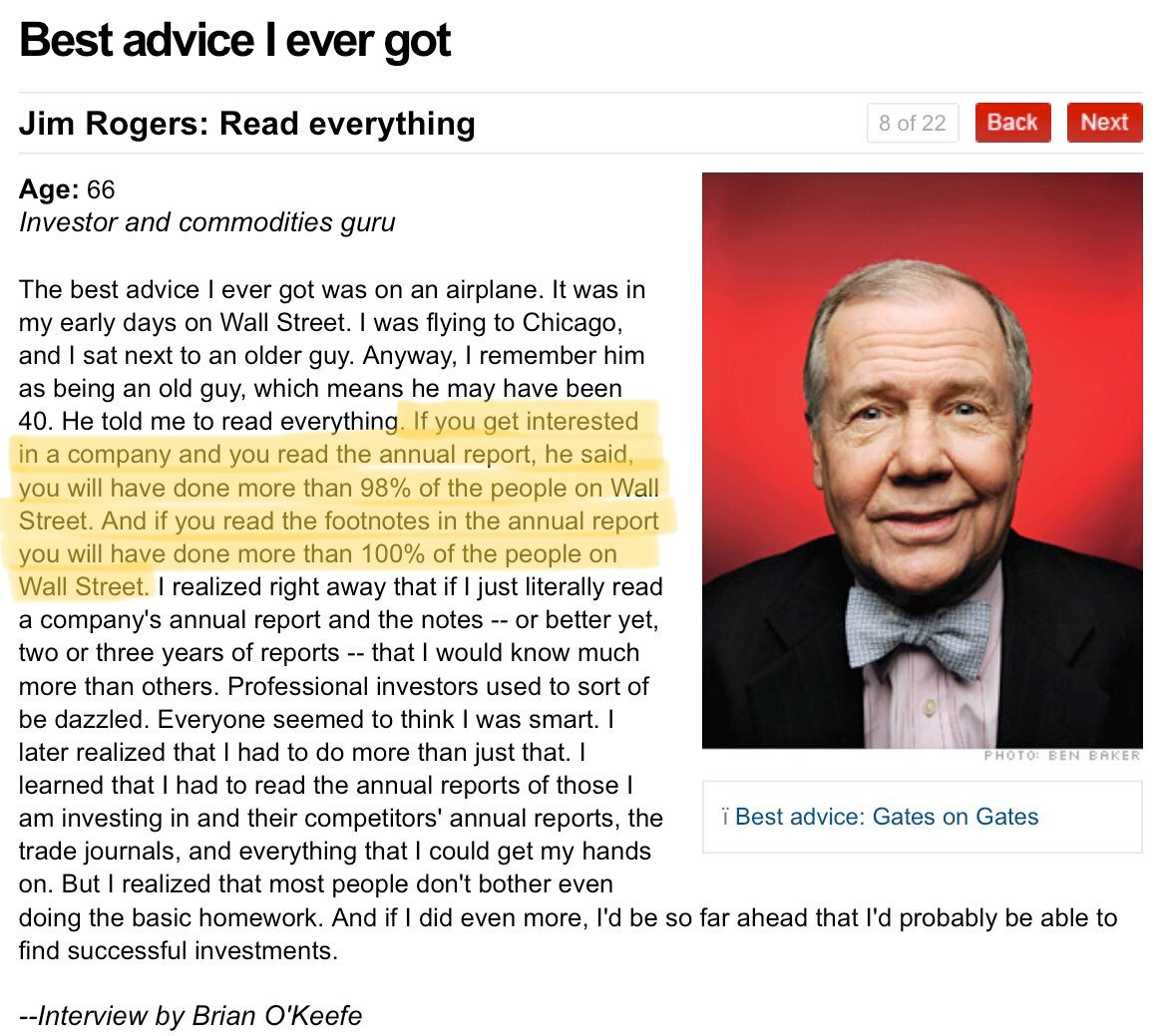🔍 How to analyze a 10-K
It’s always crucial to understand the companies you invest in.
A 10-K tells you everything you need to know about a stock.
In this article, you’ll learn how to read a 10-K like a professional.
The importance of a 10-K
According to Jim Rogers, 98% (!) of people on Wall Street don’t read the annual report. As a Fund Manager, I can confirm that most professional investors don’t read the 10-K before they invest in a company.
This means that you can create a BIG advantage for yourself if you read 10-Ks.
Successful investing is hard work. The best way to outperform the market is by becoming a learning machine.
What is a 10-K?
Every year, companies must publish their 10-K. It’s the most important document a company publishes. The better you know how to read an annual report, the better you’ll be able to understand the companies you invest in.
But what is a 10-K?
A 10-K is an official document that contains a lot of information about the company. The SEC requires US listed companies to publish this report to inform (potential) investors about their financial conditions. You’ll learn about the company’s history, it’s organizational structure, financial statements, executive compensation and so on.
Structure of a 10-K
The beautiful thing about a 10-K is that they all have the same structure.
This means that the more 10-Ks you read, the faster and the better you’ll get at it.
The structure of a 10-K looks as follows:
Business: an overview of the company’s main operations including its products and services. This section shows you how the company makes money
Risk factors: shows the major risks of the company. The risks are typically listed in order of importance
Financial statements: specific financial information about the business
Management discussions and analysis (MD&A): Management's view on the business results of the past fiscal year
We’ll now dig into each section using Visa as an example. You can find Visa’s 10-K on the Investor Relations section of their website.
1. Business
This section describes the company’s main products and services.
It's a good place to start as it tells you how a company makes money.
It’s very important to always invest within your circle of competence. If you don’t understand the business model, you can skip the company right away.
The business segment can usually be found at the beginning of the 10-K.
2. Risk factors
This section shows the risks a company faces, usually listed in order of importance.
Going through this section is very important. As Benjamin Graham once said:
“The essence of investment management is the management of risks, not the management of returns."
When a company has a lot of goodwill on its balance sheet, generates a significant percentage of its revenue from a few clients, has low margins, or is active in a highly competitive market, it increases the risk for you as an investor.
3. Financial statements
As an investor you want to buy financially healthy companies with high margins and plenty of reinvestment opportunities.
That’s why the Financial Statements are one of the most important sections of a 10-K.
There are 3 Financial Statements in a 10-K:
Balance Sheet: gives you an overview of a company's main assets and liabilities. You want to invest in companies which don't have too much debt
Income Statement: shows the company's revenues and expenses over a certain period. You want to invest in profitable companies which can grow their revenue organically at an attractive rate
Cash Flow Statement: gives an overview about how much cash goes in and out a company over a certain period. You want to invest in companies that are cash flow positive
We’ll dive deeper in every financial statement in our next articles.
4. Management discussions and analysis (MD&A)
This section shows the view of management on the business results of the past fiscal year.
It’s always important to look at the qualitative factors behind the numbers. That’s why it’s important that management can tell its story in its own words.
Is the increasing revenue structural? Or is it because of a one-off event?
You want to invest in companies with an integer management with skin in the game. Management should always give you a reliable view about the performance of the company.
Avoid companies that do not give an honest representation of their results.
Conclusion
If you read the 10-K of a company you’ll learn a lot and create a BIG advantage over other investors
A 10-K is an official document that is published every year
The 10-K can usually be found under the Investor Relations section of a company’s website
Every 10-K consists of 4 parts: business, risk factors, financial statements and management discussions & analysis (MD&A)
More from us
Do you want to read more from us? Please subscribe to our Substack where we provide investors with investment insights on a weekly basis.
If you have any suggestions to further improve our posts, or do you want certain topics to be covered? Send us an email:
About the author
Compounding Quality is a professional investor which manages a worldwide equity fund with more than $150 million in Assets Under Management. We have read over 500 investment books and spend more than 50 hours per week researching stocks.









Perfect. Great reminder to always dig deeper with your research into a company.
Thank you very much for this helpful article.